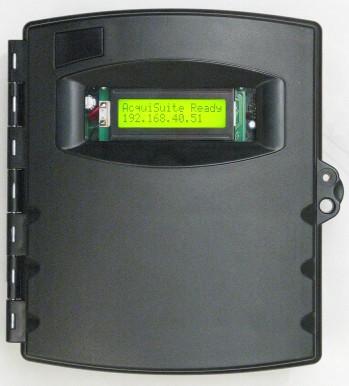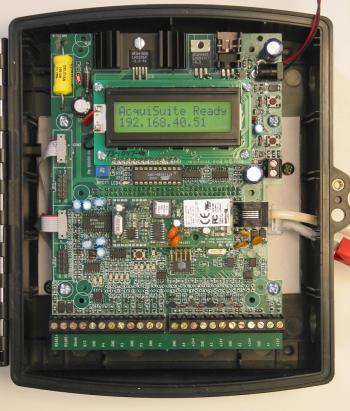Device Profile: AcquiSuite — a building automation data acquisition device
Oct 14, 2002 — by LinuxDevices Staff — from the LinuxDevices Archive — 7 viewsIntroduction
AcquiSuite is a computerized device (manufactured by Obvius — Portland, OR) which is used for building automation and energy management. The device can lower the cost of operating a building by collecting and reporting information in a reliable, timely, and inexpensive manner. Collected data is used to analyze the energy consumption in the building, and to monitor equipment operation and efficiency. For example: Is the computer room too warm because the air conditioner is not operating correctly? Is the heater coming on at the wrong times?
The AcquiSuite communicates with a variety of input hardware devices such as temperature sensors and power meters placed around a building. The data collected at specified intervals is initially stored in nonvolatile Flash memory within the AcquiSuite, and then uploaded over the Internet on an hourly or daily basis either to a central web-enabled SQL database system known as the Building Manager Online (BMO) server, or to the user's own data warehousing system. Once the data is stored on the BMO website, it can later be viewed and analyzed on any PC. Remote configuration is also provided via the BMO website, allowing administration of AcquiSuite devices that are on intermittent or shared dialup telephone lines. Customers can view historical data, plot charts, configure alarm settings, and specify email alarm notifications.

Contractors can use the AcquiSuite to monitor building operations or verify power reduction projects. Obvius has sold many devices to contractors for installation in buildings prior to a project. After several weeks of data collection, the contractor will return and install lighting or HVAC equipment to reduce energy consumption. The AcquiSuite will continue to log data after the retrofit, and the data collected is used to verify the energy cost savings. Many such contracts are written so the contractor only gets paid when the savings are verified. The AcquiSuite provides this verification with much more detail and at a lower price than has previously been possible.
A key advantage of AcquiSuite is that it brings 'plug and play' capability to the data acquisition market, dramatically reducing the time and training to put a typical building on line. In most applications, the installation can be done by the building engineer or contractor in less than two hours. In traditional building automation systems, the installer must type in long lists of device addresses for each data point they wish to use. This is time consuming and prone to errors. The AcquiSuite solves this problem by offering a plug-and-play style of device configuration. When a new Modbus device is attached to the AcquiSuite, it will be detected and profiled automatically. The installer will be prompted to name the device, and the rest of the configuration is handled by the system.
Traditional data systems have a telephone line interface that requires a dedicated phone line. When a user needs to collect data, a phone call to the remote system is placed and the remote system answers the line. To save installation cost, the AcquiSuite can provide data by ppp dialin or dialout modem connections as well as an Ethernet LAN interface. Users may configure the AcquiSuite to upload data during off-hours by placing an outbound call to a local ISP. This allows the AcquiSuite to share a phone line with existing fax machines. If an Internet connected LAN is present in the building, the AcquiSuite can simply use that Internet connection with no phone line at all. These features all translate to a lower install price for the end user.
What's in the box?
The AcquiSuite has an embedded computer based on a 16MHz ALI 386SX processor, 8MB RAM, and an 8MB DiskOnChip Flash disk. The DiskOnChip contains system's Linux-based operating system and is also used for data storage.
Input/output connections include RS485/Modbus, 10Mbit Ethernet, and a 33.6kbps modem. The device also provides inputs for 4 analog (4-20mA, 0-10V) and 4 pulse inputs, for logging data from pulse output utility meters or flow meters.
Because most industrial sensors in existing buildings run on 24V, the AcquiSuite was designed to run from a 24VDC power supply. Also, the unit has several screw terminal outputs to allow additional 24V sensors to be attached without additional wall-mounted power supplies.

(An annotated inside view is located here)
System software
Linux seemed to be a good fit for this product because it provides TCP/IP, serial communications, and multitasking ability at a very low price.
The system's embedded Linux OS is based on a static-compiled v2.4.19 Linux kernel (soon to be updated). Libc 5 is used to reduce space. BusyBox and thttpd are used extensively in the system. The MTD Flash technology support for the DiskOnChip also turned out to be very valuable.
The device has two sources for operator input. The 'console', a 2×16 character LCD and two buttons, provides a basic interface used for network configuration. Users can configure the IP address or select DHCP from the menus. Basic network connectivity tests can also be selected to assist in configuring the device.
The bulk of the AcquiSuite operator interface is provided by the internal webserver interface. All of the modbus meter device configuration, modem setup, and other settings are available via a web browser.
The AcquiSuite's embedded Linux based operating system was developed by Obvius from the ground up, rather than using any off-the-shelf embedded Linux toolkit or product. Development was carried out on a Red Hat 7.1 system; however the components for the target system image (stored in Flash) were all selected and compiled from scratch.
Retrospective on the development project
When the project was first started, we wrote some prototype software and set it up on a Red Hat 7.1 system to demonstrate the concept. About two months into the project, a hardware platform was selected, and the first issue that presented a challenge was simply scaling it down to fit within an 8MB DiskOnChip Flash 'disk'. Actually, we needed to reserve about 2MB of space for data storage, so we really only had 6MB of space to work with.
We found that there were several open source projects that are very useful to Embedded Linux developers. After using BusyBox to supply most of the command line utilities, and thttpd as a web server, we had no problem squeezing everything into just 4MB of Flash.
Further space was saved by using the new cramfs file system that is included within the Linux 2.4 kernel. Cramfs also allows us to provide updates for the firmware. All of the data logging software, html pages, and related files are in one cramfs image file. To update the data logging software, we simply swap out the cramfs image file and remount it.
Why Linux?
Linux provided several things that were very important to us . . .
- First, it provided a solution that got the project to market within six months.
- Linux provides complete TCP/IP functionality including PPP and many other features that enable Internet access and make it a robust platform.
- There are no royalties.
- Perhaps most important, we can fix problems in the software because we have the source code.
Everyone is very satisfied with the results.
Obvius will honor the licenses of any software we use in our product. Most of it is GPL. We often make software selection decisions based on the terms of the license. If the author of a package states that their software may not be used in a commercial product, we will honor that and not use their software.
Most of the changes we have made to GPL code up to this point have been minor, one-line changes. We have found that by the time we find a problem with something, and then look to see if it is easily fixable, someone has already submitted a similar patch to the software project's moderator. (Perhaps, one of these days, I'll get my name in a change log.)
From a practical standpoint, we would prefer to see any modifications we make be folded back into the software project. That way, we can continue to use new versions without having to re-patch our changes into each version released.
Thoughts on the future of Embedded Linux
Over the past three years, we have seen the power of low-end computers rise with the rest of the computer industry. This has allowed full-fledged operating systems such as Linux to become a viable solution in the embedded marketplace. In the future, consumers are going to expect more from embedded devices. Features such as online Flash updates and web browser interfaces are increasingly going to be mandatory.
 About the author: Stephen Herzog is Chief Technology Officer of Obvius LLC. Herzog was the founder of Secure Design, a software and consulting company that specialized in Novell NetWare, Linux, and Internet connectivity. He developed several software packages including SDProxy, a Linux based embedded firewall with web browser interface, SDLPD and QView Pro, a Novell NetWare print management system, and has extensive knowledge of embedded systems running the Linux operating system, Internet connectivity, and interactive database websites.
About the author: Stephen Herzog is Chief Technology Officer of Obvius LLC. Herzog was the founder of Secure Design, a software and consulting company that specialized in Novell NetWare, Linux, and Internet connectivity. He developed several software packages including SDProxy, a Linux based embedded firewall with web browser interface, SDLPD and QView Pro, a Novell NetWare print management system, and has extensive knowledge of embedded systems running the Linux operating system, Internet connectivity, and interactive database websites.
This article was originally published on LinuxDevices.com and has been donated to the open source community by QuinStreet Inc. Please visit LinuxToday.com for up-to-date news and articles about Linux and open source.